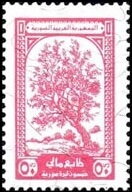Stamp: Orange tree (Syria 1980)
Orange tree (Syria 1980)
01 January (Syria ) within release Fiscal goes into circulation Stamp Orange tree face value 50 Syrian pound
| Stamp Orange tree in catalogues | |
|---|---|
| Colnect codes: | Col: SY F1980-35 |
Stamp is square format.
Inscribed "Syrian Arab Republic" and "Revenue Stamp" in Arabic No security underprint Revenue Reverend cat. no: R715Also in the issue Fiscal:
- Stamp - Orange tree face value 50;
- Stamp - Pylon and dam face value 250;
- Stamp - Scythe and fruit face value 10;
- Stamp - Scythe and fruit face value 10;
- Stamp - Spade and ear of corn face value 1;
- Stamp - Tabqa Dam face value 100;
- Stamp - Tractor and plough face value 40;
- Stamp - Tractor and plough face value 50;
- Stamp - Tractor and plough face value 60;
- Stamp - Tractor and plough face value 90;
- Stamp - Woman holding basket of fruit face value 20;
- Stamp - Woman holding basket of fruit face value 20;
- Stamp - Woman holding basket of fruit face value 20;
- Stamp - Crane and ship face value 125;
- Stamp - Farm produce face value 2;
- Stamp - Farm produce face value 15;
- Stamp - Farm produce face value 25;
- Stamp - Farm produce face value 75;
- Stamp - Farm produce face value 2;
- Stamp - Finance Ministry building face value 25;
- Stamp - Finance Ministry building face value 4;
- Stamp - Finance Ministry building face value 25;
- Stamp - Hammer and processing plant face value 3;
- Stamp - Horse and goat face value 5;
- Stamp - Horse and goat face value 5;
|
Data entry completed
60%
|
|
|---|---|
| Stamp Orange tree in digits | |
| Country: | Syria |
| Date: | 1980-01-01 |
| Paper: | Granite |
| Perforation: | comb 12 x 11½ |
| Emission: | Revenue |
| Format: | Stamp |
| Face Value: | 50 Syrian pound |
Stamp Orange tree it reflects the thematic directions:
Agriculture is the cultivation and breeding of animals, plants and fungi for food, fiber, biofuel, medicinal plants and other products used to sustain and enhance human life.[1] Agriculture was the key development in the rise of sedentary human civilization, whereby farming of domesticated species created food surpluses that nurtured the development of civilization. The study of agriculture is known as agricultural science. The history of agriculture dates back thousands of years, and its development has been driven and defined by greatly different climates, cultures, and technologies. Industrial agriculture based on large-scale monoculture farming has become the dominant agricultural methodology.
Flora is the plant life occurring in a particular region or time, generally the naturally occurring or indigenous—native plant life. The corresponding term for animal life is fauna. Flora, fauna and other forms of life such as fungi are collectively referred to as biota. Sometimes bacteria and fungi are also referred to as flora, as in the terms gut flora or skin flora.
In botany, a tree is a perennial plant with an elongated stem, or trunk, supporting branches and leaves in most species. In some usages, the definition of a tree may be narrower, including only woody plants with secondary growth, plants that are usable as lumber or plants above a specified height. Trees are not a taxonomic group but include a variety of plant species that have independently evolved a woody trunk and branches as a way to tower above other plants to compete for sunlight. In looser senses, the taller palms, the tree ferns, bananas and bamboos are also trees. Trees tend to be long-lived, some reaching several thousand years old. The tallest known tree, a coast redwood named Hyperion, stands 115.6 m (379 ft) high. Trees have been in existence for 370 million years. It is estimated that there are just over 3 trillion mature trees in the world. A tree typically has many secondary branches supported clear of the ground by the trunk. This trunk typically contains woody tissue for strength, and vascular tissue to carry materials from one part of the tree to another. For most trees it is surrounded by a layer of bark which serves as a protective barrier. Below the ground, the roots branch and spread out widely; they serve to anchor the tree and extract moisture and nutrients from the soil. Above ground, the branches divide into smaller branches and shoots. The shoots typically bear leaves, which capture light energy and convert it into sugars by photosynthesis, providing the food for the tree's growth and development. Flowers and fruit may also be present, but some trees, such as conifers, instead have pollen cones and seed cones; others, such as tree ferns, produce spores instead. Trees play a significant role in reducing erosion and moderating the climate. They remove carbon dioxide from the atmosphere and store large quantities of carbon in their tissues. Trees and forests provide a habitat for many species of animals and plants. Tropical rainforests are one of the most biodiverse habitats in the world. Trees provide shade and shelter, timber for construction, fuel for cooking and heating, and fruit for food as well as having many other uses. In parts of the world, forests are shrinking as trees are cleared to increase the amount of land available for agriculture. Because of their longevity and usefulness, trees have always been revered, with sacred groves in various cultures, and they play a role in many of the world's mythologies.



